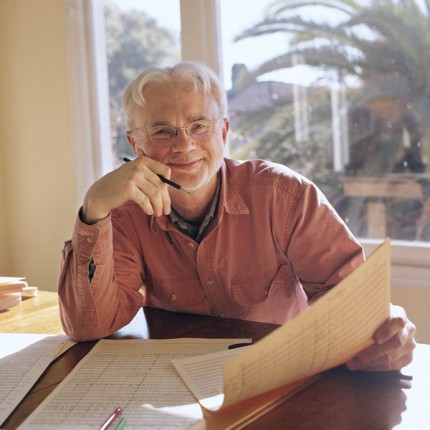Adams’ powerful yet flawed “Mary” gospel closes Ravinia season with a Midwest premiere

One can’t accuse the Ravinia Festival of wrapping this summer season with an easy-going evening of Beethoven or Tchaikovsky.
Rather, the populist multi-genre music festival closed its classical season Saturday night, with the Midwest premiere of John Adams’ The Gospel According to the Other Mary, the American composer’s most recent, large-scale work.
The life, crucifixion and death of Jesus Christ seems to be stoking composers’ imaginations once again. For many, it seems to be due more to the towering achievement of Bach’s Passions, than the spiritual inspiration that lies at the core of his music. Indeed, some seem to view the traditional gospel story—and Jesus—with something between suspicion and disdain. The dramatic narrative is more often wielded as a convenient scaffolding to frame a large-scale work and mine it for contemporary political freight, utilizing the narrative while clumsily avoiding—or even surgically removing—the specific Christian aspect that lies at its very heart.
Such is the case with two recent works that retool the familiar Christian tale from the perspective of Mary Magdalene. Mark Adamo’s opera The Gospel of Mary Magdalene, which had its world premiere in San Francisco this summer, presented an unconvincing mix of snarky putdowns of Jesus as unenlightened male chauvinist while elevating the repentant prostitute Mary to plaster feminist icon, a philosopher queen who is the real genius behind Jesus’s best lines.
John Adams’ The Gospel According to the Other Mary falls victim to some of the same hoary political ax-grinding, which prevents it from being a complete success. But musically Adams’ vast quasi-oratorio is a stronger and more consistent work.
After the rather slick superficiality of Absolute Jest, Adams showed that he can indeed still write music of depth and great expressive power that doesn’t rely solely on rhythmic impetus and scoring panache.
At over three hours including intermission, Adams’ Mary opus is cast on the grand scale, written for ample orchestra with massive battery percussion, large chorus, two mezzo-sopranos, tenor and a trio of countertenors, who act as a kind of three-headed Evangelist, narrating the traditional gospel text.
The music offers some of Adams’ most compelling work in years. There are indelible solo arias and the choral writing is striking and often stunning, as with the anticipatory dread in the Golgotha section and the ascending confused and gradually terrified voices that accompany Lazarus’s rising from the dead.
In addition to a vast bestiary of gongs, bells and assorted instruments that kept the Chicago Philharmonic percussionists busy, Adams employs a cimbalom that undergirds the orchestral textures. The Hungarian instrument has no discernible connection to the Holy Land historically or geographically yet its ancient metallic timbre sounds right for the narrative.
If at times The Gospel According to the Other Mary feels padded and overlong, it’s not because of Adams’ music, which is varied and compelling enough to hold one’s interest, but because of the tone-deaf banality of Peter Sellars’ libretto.
Adams’ bafflingly ineradicable collaborator was once a novel stage director (as with Nixon in China) but his revisionist productions in the last decade have been less successful and grown increasingly strained (his Gulf War staging of Handel’s Hercules as Lifetime Channel drama at Lyric Opera).
Whatever juice there was in this partnership has long since dried up ever Sellars’ inane libretto for Adams’ opera, Doctor Atomic. Mary Magdalene here comes to self-actualization not through any spiritual conversion but due to her identification and work with the poor and oppressed, which for Sellars is clearly the secular model to be emulated over any of that silly religious stuff.
So we get Sellars stitching together disparate social justice texts by Dorothy Day and the like, as well as providing his own leaden, adolescent and tortuous prose (“I’m walking out, my face a dustpan, my body as stiff as a new broom”) including an unfunny ode to body lice, and ponderous nods to Cesar Chavez and migrant workers that often felt like an unintentional parody of West Coast political correctness. With all the talented writers around, why does Adams continue to undermine his best efforts with the giftless Sellars as a partner?
No complaints about the performance, which seemed close to ideal in every respect, with the Los Angeles Master Chorale and soloists recreating their efforts from the Los Angeles premiere.
As Martha, Tamara Mumford brought a fluent, dark tone and refinement to her solo arias. Kelley O’Connor’s deep chest voice and theatrical intensity as Mary made one wish that she had better words to sing. Russell Thomas was a dramatic and incisive Lazarus and the trio of countertenors (Daniel Bubeck, Brian Cummings and Nathan Medley) blended well in their part as traditional Greek chorus.
Grant Gershon conducted with care and attentiveness though the performance felt a bit cautious in places. At times one wanted more corporate gleam and weight from the Chicago Philharmonic forces but they rose to the occasion gamely with committed playing of this hugely challenging score. Special kudos to the brass and peripatetic percussion players.
In many ways the evening really belonged to the Los Angeles Master Chorale. Gershon, the chorus’s music director, drew clear enunciation and vivid, richly characterized ensemble singing that consistently brought out the drama and mystery of Adams’ music. Would that they too had better words to sing.
Posted in Uncategorized


